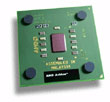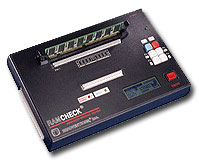|
Meet AMD's 2.13GHz AthlonXP 2600+
Hi,
Grab
a morning cup of coffee and celebrate the 3rd anniversary of the "Athlon"
processor knowing that today the 2.13GHz AthlonXP 2600+ and 2.0GHz
AthlonXP 2400+processors have been announced!
It's not very often that a CPU manufacturer adds
another notch on the Gigahertz belt, so we've added a little info in
today's newsletter on the matter. Also in this weeks edition we have
the Ramcheck Professional memory tester, Innovative's cool black LCD radial
arm support (for zero footprint display mounting) and Cornea System's affordable
MP704 17"LCD monitor.
AMD's
New 2.13GHz AthlonXP 2600+ Arrives
 First there was 2600 baud,
then there was the 2600 'Club', and now there is the brand-spanking
new AMD AthlonXP 2600+ processor running at
2.133GHz! The release of the
AthlonXP 2600+ marks two eventful moments for AMD - this is the first
Athlon processor they have released which to operates over the 2.0GHz
mark, and this on the three year anniversary of the Athlon processor. First there was 2600 baud,
then there was the 2600 'Club', and now there is the brand-spanking
new AMD AthlonXP 2600+ processor running at
2.133GHz! The release of the
AthlonXP 2600+ marks two eventful moments for AMD - this is the first
Athlon processor they have released which to operates over the 2.0GHz
mark, and this on the three year anniversary of the Athlon processor.
Alongside the Thoroughbred-based AthlonXP 2600+
is the AthlonXP 2400+ which runs at exactly 2.0GHz. In OEM quantities the 2600+
is priced at just $297USD, and the 2400+ at just under $200USD. Mainstream retailers
are expected to begin offering the new 2GHz plus AMD chips in systems by September,
just in time for the back to school buying season.
 Both processors
operate on the 266 Front Side Bus (FSB) so our hopes of a 333MHz FSB
AthlonXP are not going to be realized just quite yet. Both processors
operate on the 266 Front Side Bus (FSB) so our hopes of a 333MHz FSB
AthlonXP are not going to be realized just quite yet.
The
AthlonXP 2600+ is manufactured at AMD's Dresden Germany FAB 30 (which has not been affected by
the sever flooding in that area thanks to a lofty placement in the local landscape)
on the 0.13micron process and features 128KB of L1, and 256KB of L2
cache. The continued use of the Thoroughbred core means that the new 2.133GHz parts will
have die sizes of 84mm squared, a transistor count of 37.6million and an average
power output of 62Watts. The stepping of choice at the moment is
"AXDA."
The transistor count has increased slightly
from the previous AthlonXP 2200 stepping of 37.2 million to 37.6million. The core surface area
has also grown to 84mm squared from just 80mm squared before.
According to AMD some changes to the Thoroughbred core were implemented to
"add an additional layer of metal of reduce resistance and capacitance." Additionally, decoupling
capacitors have been added to reduce electromagnetic interference (EMI). The AthlonXP core is
essentially unchanged from an architecture standpoint, and will remain so until the release of
Barton which is road mapped for release in this half of 2002.
 At a cost of just under $2,000 USD for the
standard unit, the Ramcheck memory tester comes in fairly inexpensive in a
market populated by large desktop testers that can range in price from as
much as $8,000-$26,000USD. Depending upon individual requirements, expansion
adaptors can be used to widen the capabilities of the Ramcheck from
standard 168-pin SDRAM through to DDRAM, SODIMM, SIMM, and even individual
TSOP memory modules. The versatility of the unit is quite unique, though
at first glace it presents a more humble impression. The Ramcheck owes much of its boxy look to the previous memory
tester Innoventions offered, the Simcheck II. By maintaining a cohesive
layout, the company assured that users of its's earlier generation memory
tester could easily upgrade their unit to the more current Ramcheck simply
by switching out a component PCB board. At a cost of just under $2,000 USD for the
standard unit, the Ramcheck memory tester comes in fairly inexpensive in a
market populated by large desktop testers that can range in price from as
much as $8,000-$26,000USD. Depending upon individual requirements, expansion
adaptors can be used to widen the capabilities of the Ramcheck from
standard 168-pin SDRAM through to DDRAM, SODIMM, SIMM, and even individual
TSOP memory modules. The versatility of the unit is quite unique, though
at first glace it presents a more humble impression. The Ramcheck owes much of its boxy look to the previous memory
tester Innoventions offered, the Simcheck II. By maintaining a cohesive
layout, the company assured that users of its's earlier generation memory
tester could easily upgrade their unit to the more current Ramcheck simply
by switching out a component PCB board.
Article Link:
 It's official, the desktop has been liberated! No
longer is your poor desk a captive of 50 pound blocks of beige and glass!
The standard TFT LCD display was the first step in this liberation; with
less bulk than a CRT it freed up a good foot or two of desk space. By
adding a desk or wall mounting adjustable armature next, an LCD
display can effortlessly float above the entire desktop, yielding the much
coveted "Zero Footprint" many have been looking for. Of course if you are
going to suspend a $700 or $1400USD LCD display above a desk, or from a
wall you had better be sure whatever is holding it up is strong, and well
built. It's official, the desktop has been liberated! No
longer is your poor desk a captive of 50 pound blocks of beige and glass!
The standard TFT LCD display was the first step in this liberation; with
less bulk than a CRT it freed up a good foot or two of desk space. By
adding a desk or wall mounting adjustable armature next, an LCD
display can effortlessly float above the entire desktop, yielding the much
coveted "Zero Footprint" many have been looking for. Of course if you are
going to suspend a $700 or $1400USD LCD display above a desk, or from a
wall you had better be sure whatever is holding it up is strong, and well
built.
Article Link:
AMD vs. Intel: It's An Eternal
Struggle |
|
Cornea Systems MP704 17inch TFT
LCD Display |
|
I find it very amusing when I get an email
calling me an AMD zealot or saying that I am bias towards AMD. I
have never considered myself "loyal" to either AMD or
Intel, I simply go with whomever is faster. Since I upgrade my motherboard and/or CPU pretty much every
six months I have an interesting dilemma ... Should I stick with an
AMD setup and get a Thoroughbred processor or should I perhaps do
something more radical and go with a Pentium 4?
Article Link |
|
Objects
which were once considered the playthings of people with too much
money to spend have dropped down to more reasonable pricing,
and users have embraced them
fully. Consumers are looking through the mass of LCD's which have
been introduced in the last two years, searching out for the best
deals, and the best features, and while larger
companies like Viewsonic, Samsung, NEC, Hitachi and LG may control
the marketplace there are a good many smaller manufacturers also
worth consideration. Article Link |
Colin's Weekly Tech Tips
By: Colin "3DMark" Sun |
 Drivers Can Help Fix It
I hear from a lot of people who are frustrated with compatibility problems, or performance problems that could be solved with a simple driver update. Most of the time you won't notice any
performance
increases with driver updates, but they can work out compatibility problems that make things run smoother. There was the infamous SB Live! and VIA 686B chispet problems, then the issues with some nVidia videocards that BSOD while in WindowsXP; yet both these minor issues were fixed with subsequent driver updates. When nVidia released the DetonatorXP's, GeForce3 owners even noticed up to a 25% boost in performance!
When was the last time you remembered to update your computers drivers? You might not get a performance increase, but a few key (motherboard chipset, videocard, and OS) driver updates will probably keep your system running smoothly and free of compatibility problems much longer! Colin's Tech Tips have been archived for your reading
enjoyment!
|
Have you stopped by the PCStats Forums yet? It's one of the fastest growing hardware communities and
it needs your brilliant computer knowhow to become even
better!
|
|
PCstats
Issue No.52
Circulation 135,460
The High Tech Low Down
With C. Angelini |
|
Like last week, the rumor mill is running
at flank speed. AMD and Intel are
at the top of the list as both manufacturers are readying to compete
with processor launches, purportedly separated by a few days.
AMD just today announced a colossal jump
to 2.133GHz (or Athlon XP 2600+ if PR ratings
whet your whistle) while Intel takes the evasive maneuvers necessary to maintain a performance advantage. The latest Athlon XP processors don't support the mythical 333MHz bus though. A host at Quakecon 2002 alluded that the first 333MHz processor will be AMD's Athlon XP 2800+ chip.
However, NVIDIA's CEO has confirmed that the
upcoming NFORCE2 will support the new front side bus
speed. What hasn't been confirmed, though, is the chipset's memory support. Validating DDR400 memory has apparently become a bit of a chore, so it may be a while before NFORCE2 is able to utilize the faster memory technology.
VIA is apparently
experiencing similar teething problems. The KT400 chipset was
unveiled this past week, and despite the seemingly obvious naming
scheme, DDR400 memory is not officially supported. Go figure. Maybe
memory manufacturers are dedicating more time to DDR-II (which
NVIDIA will be using for the next powerful graphics card)?
|
| Contest Corner |
What you can WIN as a PCstats newsletter subscriber.
· There are two small silver prizes coming up... but you'll
have to wait till September 1st to find out what they are!
|

Media and Advertising Enquiries.
|
